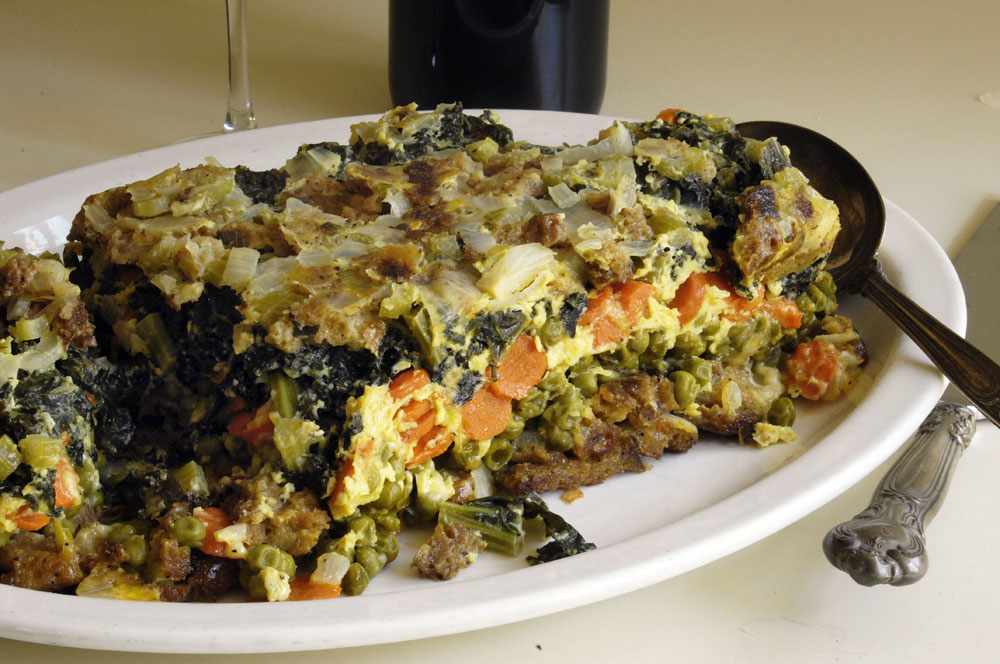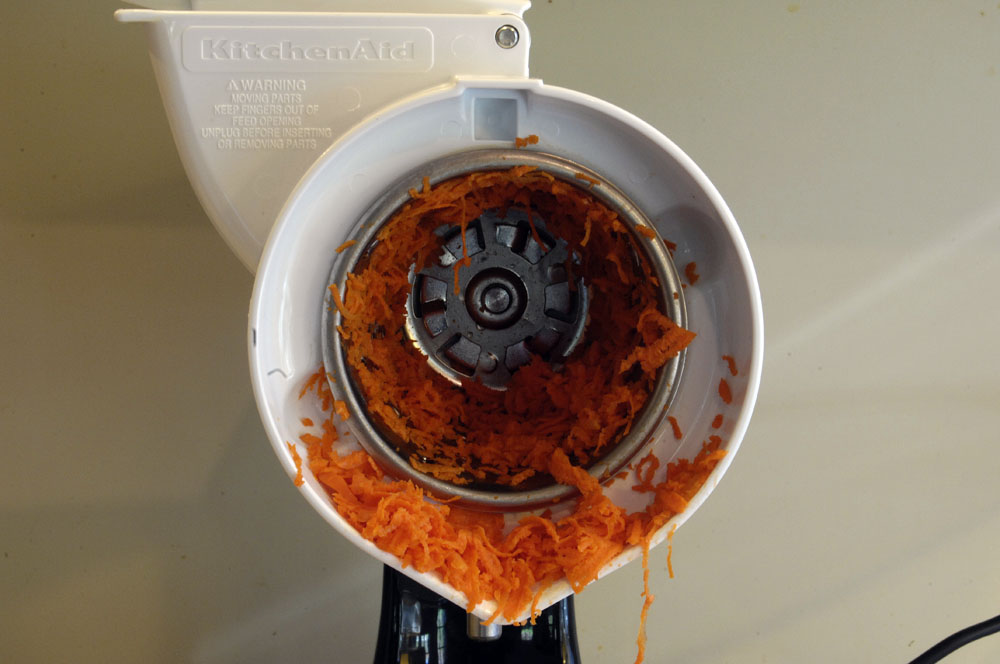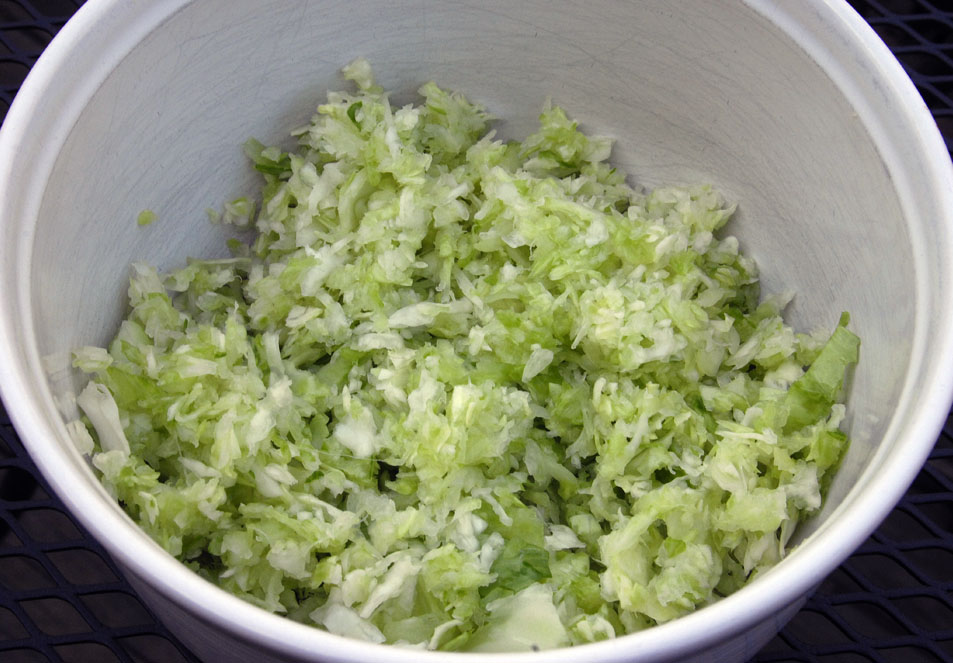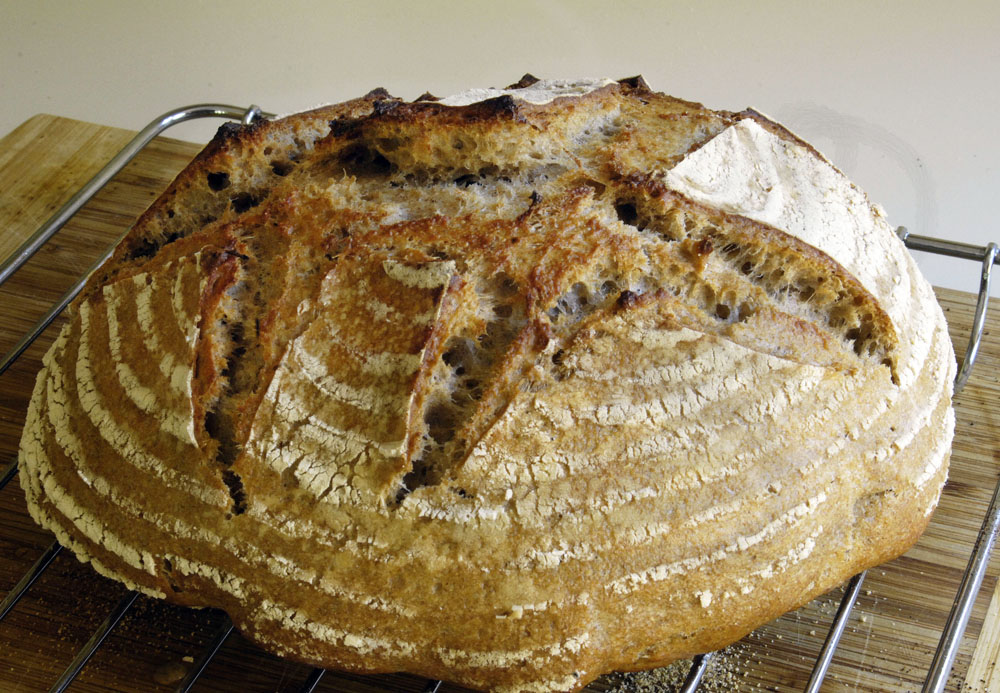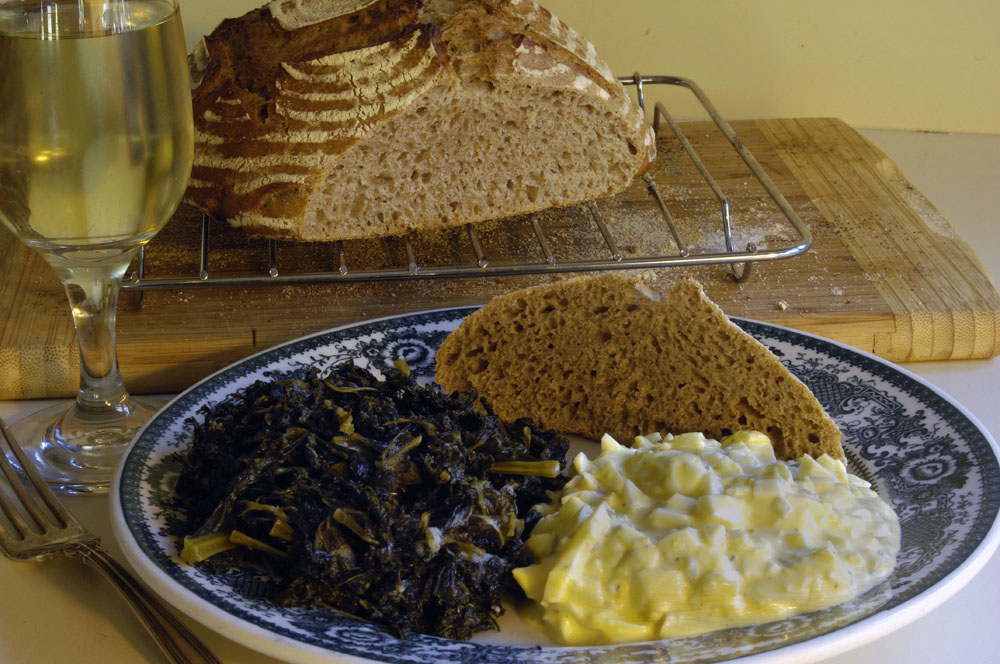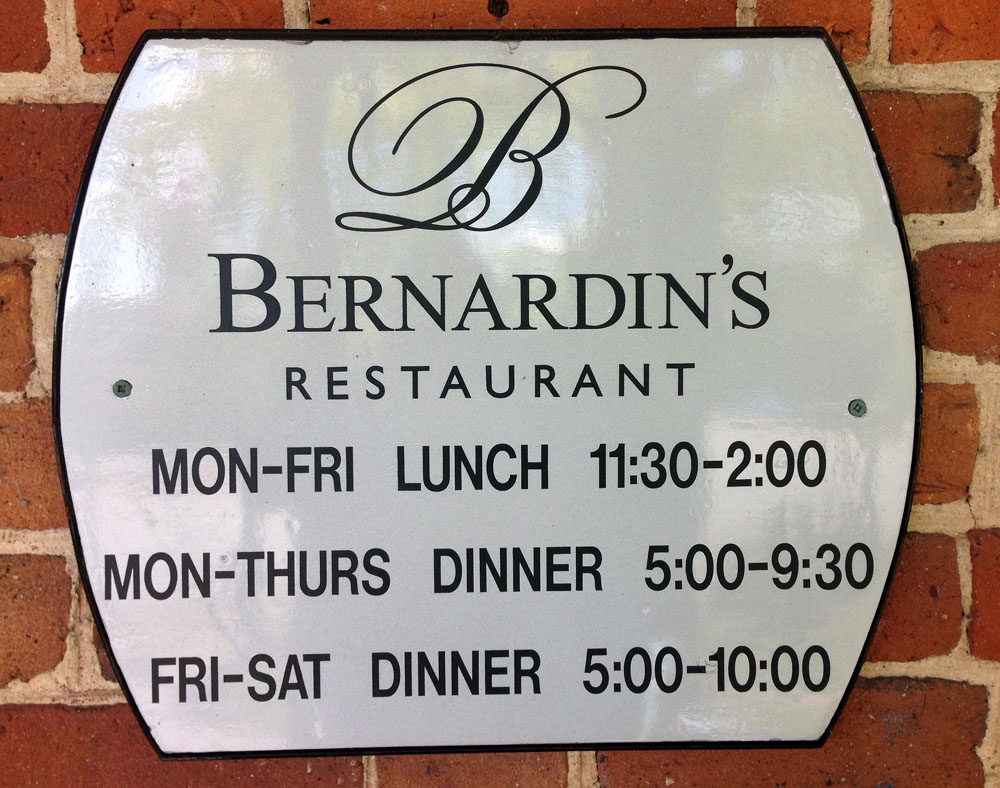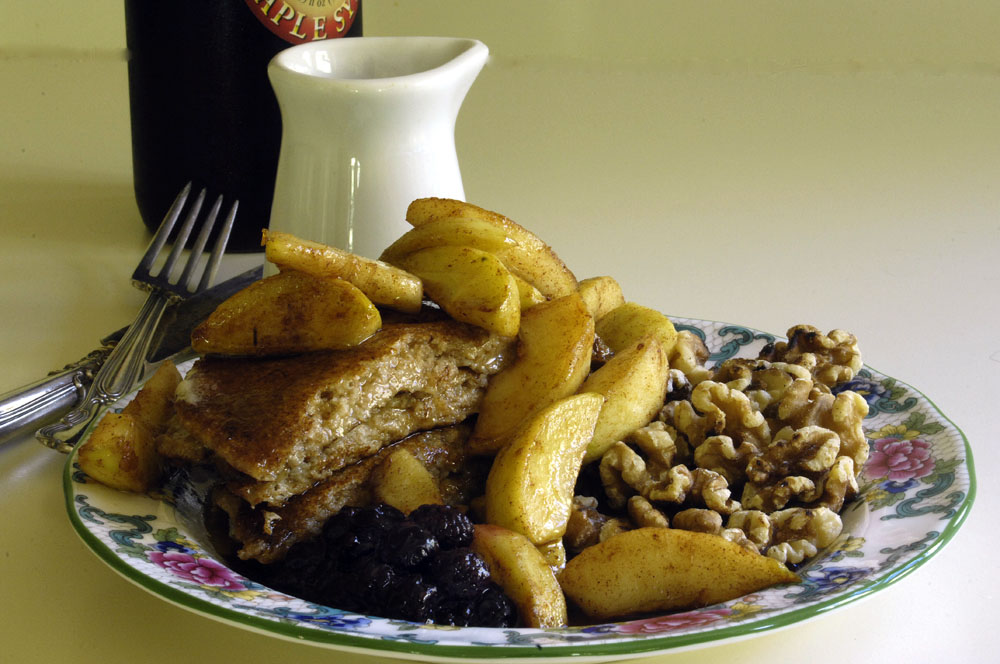Click on image for larger version
Still life with roses
Eight days ago at Trader Joe’s, on impulse, I bought a bundle of 20 roses because the price was agreeable. I expected them to last four or five days at best. But, more than a week later, they’ve opened nicely and are still going strong.
Pots of flowers always remind me of San Francisco. If you rode a bus home from downtown on a Friday, half the people heading home on the bus would have a bundle of flowers in their lap — especially the guys taking them home to their girlfriends and boyfriends. It was a tradition in San Francisco — fresh flowers for the weekend.
I think I will put fresh flowers on my shopping list each week. It’s amazing how they light up the house during the winter.
The just world hypothesis

The Yoda fountain in the Presidio of San Francisco, a place that I used to frequently visit
When you’re writing a novel, you never know what line of research you might get pulled into. Writing Oratorio in Ursa Major required that I think a great deal about justice. I’ve posted previously on this subject in “A little moral reasoning,” about Cecil the lion, and “Should we tolerate the intolerant.” One of the questions that interests me is why we tend to be so bad at moral reasoning and how much harm that does in the world.
Just recently at a meeting of the Walnut Cove town board, I heard a bitter old fundamentalist preacher haranguing the board about its prayer policy, saying that atheists have no moral foundation. How strange, to think that a species that can produce a Mozart or an Einstein is unable to grapple with the principles of moral philosophy without referring to ossified old texts.
Just a couple of weeks ago, there were stories in the media about research (also here) showing that the children of religious families are meaner and less altruistic than the children of non-religious families. This obviously is the opposite of what religionists would have us believe.
But religion certainly is not the only factor that distorts thinking. The just world hypothesis is another big one. It might be better to call it the just world fallacy.
It was the social psychologist Melvin J. Lerner who came up with the term, based on research going back to the 1960s. It boils down to a cognitive bias toward thinking that people deserve what they get and get what they deserve. It is particularly damaging to the social fabric when people believe that some people deserve misfortune because they somehow brought it on themselves.
For example, the Republican Party — and many religious people — believe that poor people are poor because they’re lazy, or there’s something wrong with their culture. The flip side of that is believing that rich people possess some kind of virtue that makes them deserve to be rich.
The writer Barbara Ehrenreich has written some popular books that touch on the just world fallacy — for example, Bright-sided: How Positive Thinking Is Undermining America.
In a YouTube video of a reading she gave at the Harvard book store, she talks about how preachers of prosperity doctrine such as Joel Osteen teach their poor followers mantras such as, “I admire rich people, I bless rich people, I love rich people, and I am going to be one, too.” According to this theology, “God wants to prosper you.”
It follows that, if you’re poor, it’s your own fault. You’re crossways with God. And, if you’re rich, you’ve pleased God and God is “prospering” you. Many rich people seem to believe that. Lots of essays and op-eds have been written about rich people strutting as though they’re the masters of the universe, automatically deserving of our deference and respect.
But the just world fallacy is not by any means limited to Republicans and religious charlatans such as Joel Osteen. New Age types buy into it, too. Having lived in the San Francisco Bay Area for years, this type of magical thinking is everywhere: “Do what you love, and the money will come … You control your destiny.” Think of self-help books such as, How to Get the Love You Want in 48 Hours. Everywhere there is the idea that you always get what you attract to yourself, that your thoughts and attitude have some sort of magical power to reshape the universe according to your desire. To be “negative” is to open the door to the devil. We’re told to avoid “negative” people, because their attitude is holding them back, and it’s contagious.
The concept of karma, actually, in Buddhism and Hinduism is a codification of the just world hypothesis. It helps sustain the Indian caste system.
I don’t know about you, but I hate seeing people get what they don’t deserve when so many people don’t get what they do deserve. Just-world doctrine would say that my attitude must be condemned as envy. Lerner’s big concern about the just world hypothesis is that it blinds us to the real sources of inequality and injustice and stands in our way of being motivated to do what we can to achieve greater justice.
It happens that John Rawls, in A Theory of Justice, has a good bit to say about envy. He acknowledges, of course, that envy in many circumstances can be toxic to the social environment. But Rawls describes a type of envy that he calls justifiable envy — envy of goods that some people acquire (and that others are deprived of) because of unjust or unequal social arrangements:
Yet sometimes the circumstances evoking envy are so compelling that given human beings as they are no one can reasonably be asked to overcome his rancorous feelings. A person’s lesser position as measured by the index of objective primary goods may be so great as to wound his self-respect; and given his situation, we may sympathize with his sense of loss. Indeed, we can resent being made envious, for society may permit such large disparities in these goods that under existing social conditions these differences cannot help but cause a loss of self-esteem. For those suffering this hurt, envious feelings are not irrational; the satisfaction of their rancor would make them better off.
Many social movements including the Civil Rights movement have been at least partly driven by justifiable envy for undeserved goods and privileges that some have and others don’t have (and — admit it — can’t get no matter how hard they try). And note Rawls’ references to self-respect and self-esteem. Not only are we blind to ways in which people are deprived of goods and privileges that others take for granted, we also put down the have-nots. We believe in the inferiority of the have-nots and expect them to believe in their own inferiority. They are children of a lesser God, creatures of a separate (and not equal) moral universe. Some will be crushed; it’s just too much for them. Among the stronger, sooner or later, rebellion is guaranteed, even if it’s a lonely rebellion of one.
In the world as it really is, most of us will never be rich. Sometimes what goes around does not come around. Sometimes what comes around is not what is fair and just. This is one reason we love stories — stories are a compensation for an unjust world. Stories (this is especially true of science fiction) are a vehicle for trying out ideas about how things might be otherwise.
In fiction and in stories, the just world hypothesis usually applies. In the end, protagonists get their heart’s desire, but not until they have striven and suffered to get it — not until they deserve it or have defeated the forces that stood in their way. And at the end of the story, bad actors get the punishment they deserve. I realize that there are dissident or experimental forms of fiction in which the just world hypothesis does not apply, but in “classical” form storytelling, the just world hypothesis applies. The justice we find in stories serves as an escape from, and a compensation for, our inability to write the story of our own lives however we please. Yoda was right about the Force, but only because Yoda lives in a story.
There is a substantial body of academic research and literature on justice and the social psychology of justice. Lerner’s books, for reasons I have not been able to figure out, are very expensive. As far as I can tell, though, this material is scattered and is often behind paywalls. Though Barbara Ehrenreich’s books have helped bring the just-world fallacy to our attention, I’m afraid the world is still waiting for a popular book that pulls all this research together and shows how it affects our world.
Casserole? Or terrine?
It’s casserole season. I wanted to experiment with the casserole’s layered French cousin, the terrine. What I ended up with was a bit too rustic and Irish looking to properly be called a terrine, but it sure was good.
I used a layer of peas, a layer of carrots, a layer of kale, and a layer of breadcrumb dressing similar to holiday dressing. I used grated cheese to hold the carrots together, and some beaten eggs to hold the pea, kale, and breadcrumb mixtures together. I used a lot of celery and onions in the dressing, and a bit of sage.
If you use nice ingredients for your layers, and if you season everything nicely, you can’t go wrong. Casseroles take time, but they make fine leftovers, so all things considered casseroles probably cut down on overall cooking time.
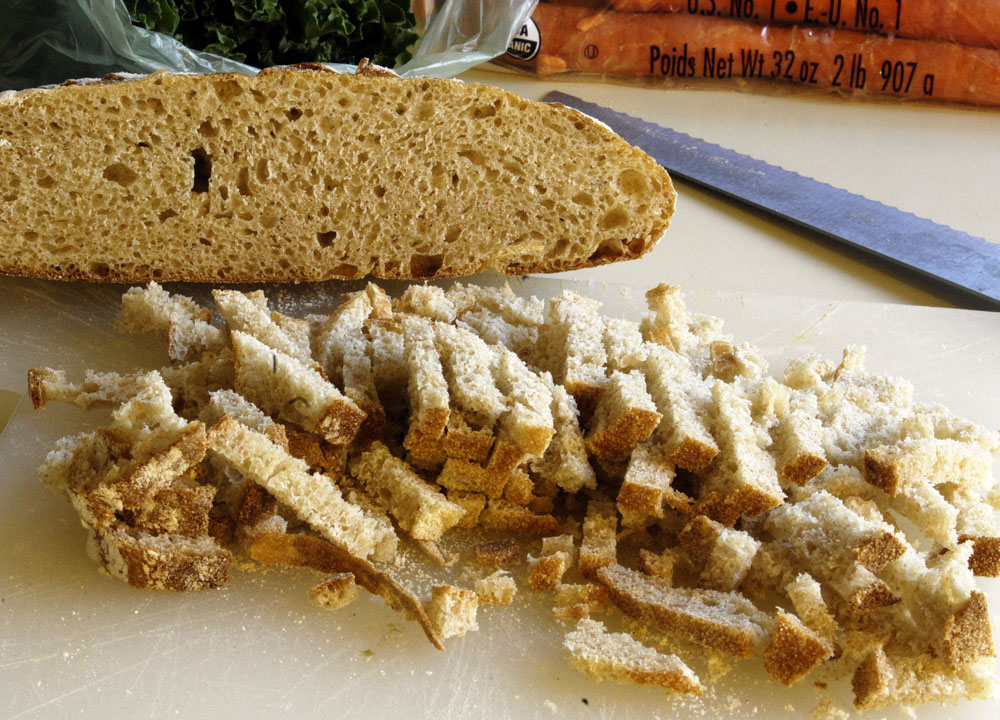
Bread never goes uneaten. Either it’s made into toasted bread crumbs or French toast, or the chickens get it.
Cupcakes and beyond
Is it just the time of year? For some reason, I had been thinking a lot about hearty dessert breads — things with carrots and pumpkins in it. I saw some carrot cake sitting on the counter in a country restaurant, and it almost overcame my will power. But I resolved then and there to make a healthier version at home.
As usual, I looked at a lot of recipes for ideas and inspiration, then came up with my own recipe. I call these treats cupcakes because “cupcakes” is a nicer word than “muffin,” but in truth they’re probably muffins, because they’re a bit heavy to be called cake. However, add a little cream cheese icing (I did, with a whiff of nutmeg in it) and the difference between a muffin and a cupcake fades.
I also confess that I splurged again on equipping the abbey kitchen. I have never owned a stand mixer, though I have always admired the design of the Kitchenaid mixers. They’re beautiful machines. In the past, I’ve felt that I couldn’t justify the cost of a Kitchenaid mixer (or find the counter space for it). But I finally deceived myself into believing that the purchase was justified. For one, I make pretty much all my own bread. That’s a lot of kneading, and a heavy-duty mixer does a fine job of it. For two, I wanted to be able to make good homemade mayonnaises with home-laid eggs and good olive oil. And a little whipped cream every now and then never killed anybody.
Then I learned that Kitchenaid makes a shredder/slicer attachment, so that sealed the deal. Previously, I have sworn by the Wear-Ever hand-cranked shredder (no longer made, but often available on eBay, where I got mine several years ago). Since the Kitchenaid follows a similar (though motor powered) design, I had high hopes for the Kitchenaid shredder.
The difference between the two shredders is a wash, really. The Kitchenaid shredder cones are slightly larger, and the Kitchenaid is probably safer because of its feed system, but the Kitchenaid blades aren’t as sharp as the Wear-Ever blades, and when making slaw with the Kitchenaid the cabbage is a little bruised and crushed (not necessarily a bad thing). Then again, it may take me some time to figure out the best way to cut cabbage in chunks and feed it to the shredder. Carrots, however, shred beautifully. The Kitchenaid shredder attachment (sold separately) comes with four slicer/shredder cones. I’ve tried only two of them so far.
Here’s my recipe for cupcakes with shredded carrots, apples, and coconut.
Heavy but reasonably healthy cupcakes
1 1/2 cups grated carrot 1 apple, peeled and grated 1/2 cup dry, unsweetened, store-bought shredded coconut 1 cup stone ground whole wheat OR sprouted whole wheat flour 1/2 cup unbleached flour 3/4 cup sugar 1 1/2 teaspoons baking powder 1 teaspoon salt 1 teaspoon cinnamon 2 eggs 1/2 cup oil (I used olive oil) 2 tablespoons milk (if needed)
Sift the flour and combine all the dry ingredients in a bowl. Set it aside.
Whip the egg whites until they’re stiff but not dry. Add the other ingredients including the egg yolks except for the milk and dry ingredients and mix well.
Add the dry ingredients to the mixture in portions, mixing as you add. The batter should be pretty thick, but if it’s too thick, add the milk.
Put the batter into a cupcake pan (I used paper liners). Makes about 10 cupcakes.
Bake at 350 degrees for about 20 minutes, or until the cupcakes pass the toothpick test (about 205 degrees F internal temperature).
I feel guilty and acquisitive and materialistic for spending money again on the abbey kitchen, but I do like fine machines. And I would like for the abbey kitchen — a serious and well used kitchen — to be able to do everything that a commercial kitchen can do, though in a smaller way.

My old way of making slaw, and still a fine machine

A different — and not necessarily better — way of making slaw
A plague of inedible pumpkins

The pumpkin above is a proper “pink pumpkin” for cooking.
I have never used canned pumpkin and never will. It has never made sense to me to open a can for something that’s so easy and fun to work with. However, it’s getting more and more difficult to find cooking pumpkins. Increasingly in the fall, the pumpkin market is flooded with the bright-orange, ugly shaped, so-called Halloween pumpkins.
A friend who works for the county’s agricultural service had posted a photo on Facebook of a bunch of Halloween pumpkins. That seemed like a good opportunity to ask a knowledgeable person why old-fashioned cooking pumpkins have gotten so much harder to find. He posted this, which perhaps was copy/pasted from elsewhere. I apologize for not knowing the original source:
“The bright orange non-edible pumpkin is a relatively recent phenomenon. In the 1960’s Massachusetts farmer John Howden wanted to breed a pumpkin that was easy to carve (Jack-O-Lantern). The criterion — thick stem (lasts longer), shallow ribs, and thin flesh relative to its size (easier carving) — resulted in the Howden variety pumpkin. The Howden totally dominates the Jack-O-Lantern market today. The public desire for other decorative pumpkins led to the proliferation of bright orange pumpkins that dominate roadside markets, grocery, and big box stores.”
So there you have it. I needed a cookable pumpkin for a pie this week, and I finally found one at one of our local treasures, Priddy’s General Store.
If I had a field (and I don’t), I’d love to grow pumpkins. They need more space, though, than I can provide.
And here’s a bit of pumpkin trivia. While writing Oratorio in Ursa Major, I wanted to light an outdoor festival as it might have been lit in 48 B.C. Knowing that jack-o-lanterns come to us from Europe and that pumpkins didn’t, I wondered how all that worked. The research was clear enough — the early Europeans used turnips for lanterns the same way we now use pumpkins. Once pumpkins became available, pumpkins ruled.
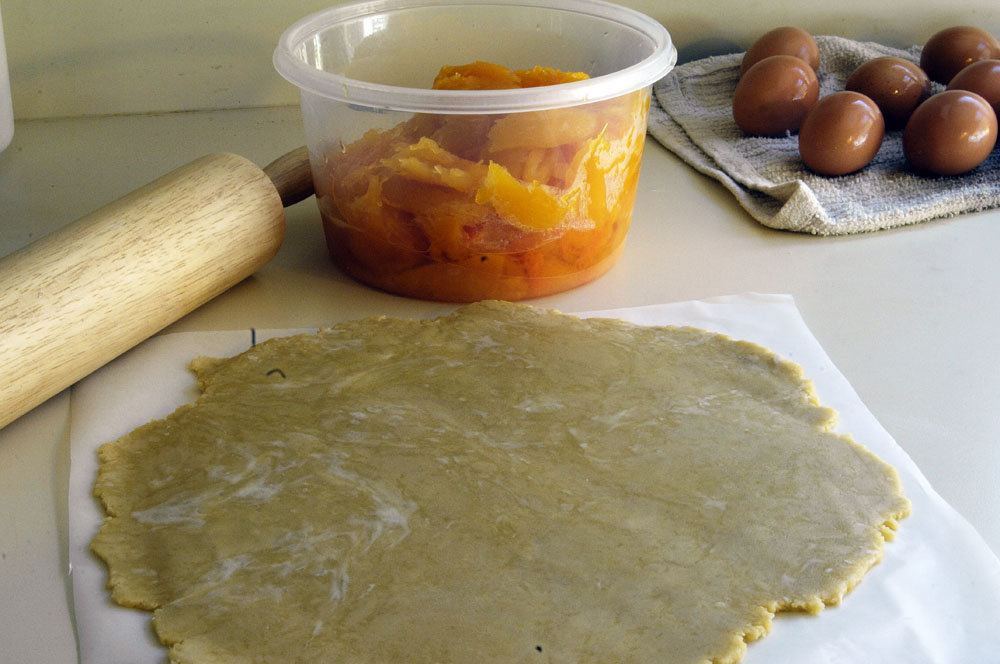
Above, rolling out the crust after the pumpkin flesh had been cooked in the steam oven. Pumpkins produce a lot of juice when they’re cooked, and the pumpkin flesh needs to be well drained before making a pie. I always save the pumpkin juice for soup stock.

A field of the wrong kind of pumpkins, near Bell Spur, Virginia
Cuisinart CSO-300 steam oven: a re-review
I’ve had the Cuisinart CSO-300 steam oven for three months now. It deserves a re-review.
This oven has earned its way into the same category of possessions as my camera: I’d panic if I suddenly didn’t have it. After three months, I can’t imagine not having it in the kitchen. To cook without it would be a huge downgrade.
My primary reason for this is bread-baking, using the the oven’s steam function. Not until I had this oven could I really make artisan breads at or near the professional level.
The next most important factor, I think, would be reheating leftovers. Granted, most people use microwave ovens for that. However, I abhor microwave ovens and haven’t had one for years. I don’t like what microwave ovens do to foods. Whereas the combination of steam and convection in this Cuisinart ovens warms up leftovers very fast and makes leftovers taste fresh made.
Another important factor is convenience and energy savings. My big oven now seems impossibly slow and limited, and I hardly ever use it now. Not only does the big oven take a long time to preheat, it also takes a long time to cool down. The energy use is substantial, and it creates a huge heat load in the house in summer weather. The Cuisinart oven is somewhat better insulated than most countertop ovens. It preheats very fast.
Today I gave this little oven its first good cleaning. Cuisinart recommends running the oven with the steam setting, set at 210 degrees, for 30 minutes, before cleaning. This does seem to loosen the crud somewhat, though not by any means will it render the oven spotless. The interior is stainless steel. It’ll look nice and clean after you’ve cleaned it, but some of those brown spots are going to be permanent.
It does take time to get used to this oven. One learns to keep tall items away from the upper heat element, so that the tops of whatever you’re cooking won’t brown too fast. Another hot spot to avoid is the convection outlet. This is no big deal when you get used to it. Yes, it would be nice if the oven were a little larger, but if it were larger it would be a problem finding counter space for it in my kitchen. So I think Cuisinart probably made a good compromise on the oven’s size.
If I have complaints, they’d chiefly be about the oven’s digital controls. The bread function, regardless of total baking time, applies steam for the first seven or eight minutes of baking, and that’s not adjustable. That’s not enough steam time. Bread will continue to rise in the oven for longer than that. I get around this by restarting the steam function as soon as it stops, for a total of 14 minutes of steam. It’s also a little annoying that, while the oven is baking, the time remaining is displayed on the screen, but the temperature is not, even though there’s plenty of screen space. I’m going to guess that Cuisinart will improve its control programming in later models.
Amazon sells this oven for $225 right now, shipping included. That seems like a bargain to me. You’ll want this oven only if you’re looking for the steam function. Otherwise a simpler and less expensive oven will do the job for you. But keep in mind that the steam is useful not only for bread baking but also for reheating leftovers and for cooking rice dishes or other casseroles that tend to dry out in the oven. Many people swear by steam roasting for things like chicken. However, I don’t cook chickens, so I can’t testify to that.
My hope is that steam ovens for home use catch on. Then not only might Cuisinart come out with other models, but competitors also will get into the market. Commercial steam ovens are very expensive, but I’m now convinced that serious cooks seriously need steam baking at home.
I rarely watch cooking shows because I rarely watch television, but if Cuisinart was smart they’d get some television cooks to start using these things. Then everybody would want one, and we’d soon have a great market in steam ovens for home use.
Bread update
I apologize for bragging, but after considerable practice, I’m ready to claim that I’m now as confident with sourdough artisan breads as I long have been with traditional yeast breads. The keys are the right guidebooks (chiefly The Breadmaker’s Apprentice by Peter Reinhart), a steam oven (the Cuisinart CSO-300), a few simple tools like a baker’s stone, a peel, and a razor-blade lame for slashing the tops, and lots of patience.
One of the best discoveries I’ve made in the last year is sprouted whole wheat flour. It has turned out to be much easier to work with than whole wheat flours. And sprouted flour almost certainly is even healthier, with a lower glycemic index and easier digestibility. When getting a start with sourdough artisan breads and pursuing your practice, I think that one is pretty much obliged to work with unbleached bread flour. But once you’ve got that down pat, you can move on to more challenging flours such as sprouted whole wheat.
Sprouted whole wheat flour loves being fed to your sourdough starter. However, you need to give it a little more time. Another of my discoveries (no surprise to sourdough professionals) is that sourdough bread doughs love the refrigerator. Invariably, when I split a batch of dough in half and bake part of it today and part of it a day or two later, the bread made later is better. Not only does the later bread taste better, but it’s easier to get a better crumb with coarse holes, and more oven spring. Just be sure to take it out of the refrigerator in plenty of time to get the dough up to room temperature.
It’s getting to the point that yeast breads don’t even seem like real bread anymore. Sourdough bread makes toast that is greatly superior. And while a yeast bread will be moldy on the third day, I have never seen a sourdough bread go to mold. You can toast it for days. I’m sure that it’s the lactic acid that preserves it.
The loaf in the photo above sprawled flat (as usual) when I put laid it on the baking stone in the hot oven. But by the time it was done, it had sprung straight up to almost twice as high, and the top burst open nicely.
That’s fall greens in the photo below, with egg salad from home-laid eggs.
I don’t get out much, but …
I go into Winston-Salem regularly to get groceries at Whole Foods and Trader Joe’s, but I usually get the heck out of town as quickly as possible, because I miss the peace and quiet of my hermitage in the foothills. But today I was in downtown Winston-Salem, I was hungry, the weather was beautiful, and I figured that it was high time I treated myself to a proper lunch.
None of the restaurants downtown appealed to me very much. They seemed far too trendy and aimed at a younger set. However, just west of downtown is a lovely old restaurant named Bernadin’s. I used to go there frequently years ago, before I moved to California. At the time, it was called Zeveley House. It is more or less French, and it’s as nice a white-tablecloth bistro as I know of.
I tend to be stingy, but I called a moratorium on stingy today. I ordered the grilled salmon without asking the price. I was almost shocked when the check came. The salmon, which included a salad and potatoes and vegetables, was $13. I was expecting anything from $14 to $19. The soup, which came with bread and butter, was $6.
No doubt I still think like a San Francisco person if I’m in a bistro, and I know that good food can’t be cheap. But this seemed shockingly reasonable to me. Country restaurants or the places that I called “fried fish houses” will sell you grilled salmon for the same amount or more, and you’re not likely to be pleased with what they set in front of you. But the cooks at Bernadin’s obviously are well trained, and lunch was delicious.
I will definitely do it again. I sat outside in their patio, by the way, and I was the only person there. I don’t feel the slightest stigma having lunch, or even dinner, alone in nice restaurants.

The salad that came with the salmon
Easy apples
When I was a young’un growing up in the country, people had apple trees and actually bothered to pick them up and use them. That meant that, when apples were in season, you might get them at every meal. Everybody’s favorite is apple pie, but that takes time. I don’t know about you, but for me eating apples raw (except maybe in Waldorf salad) takes some discipline.
But the easiest way to make apples that even young’uns will eat is to fry them. The word “fry” makes it sound more unhealthy than it really is. It just means cooking the sliced apples in a skillet, in butter, with some cinnamon and maybe a wee bit of sugar. The fried apples are then served like a vegetable along with supper. I don’t know of anybody who thought of fried apples as a dessert item.
Fried apples can be worked into any meal. Here the fried apples are a topping for sprouted wheat pancakes with toasted walnuts, maple syrup, and blackberry preserves.
Speaking of maple syrup, Trader Joe’s has it at a reasonable price, imported from Quebec. Don’t hesitate to buy Grade B maple syrup. I like it better than Grade A syrup because Grade B has a sassier, more rustic maple syrup flavor.



